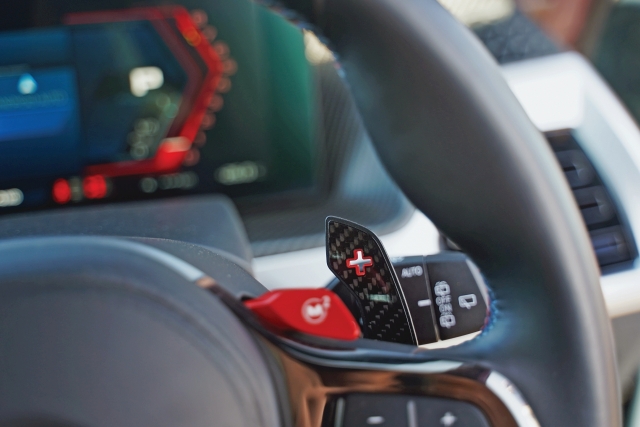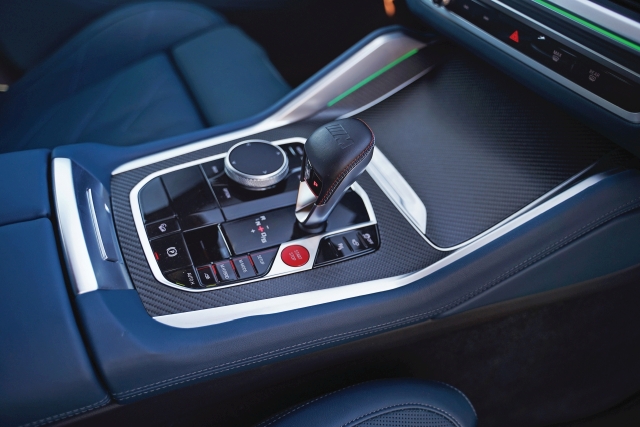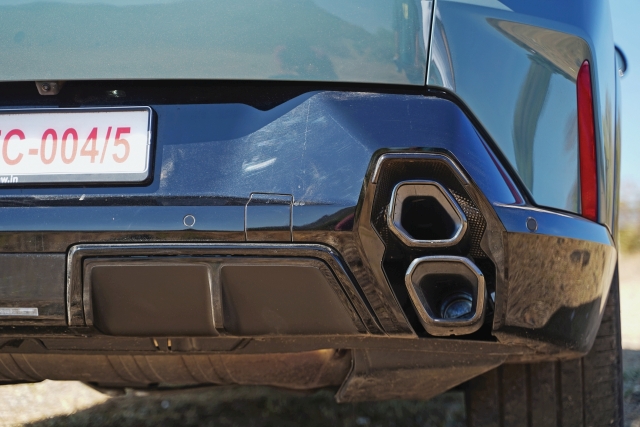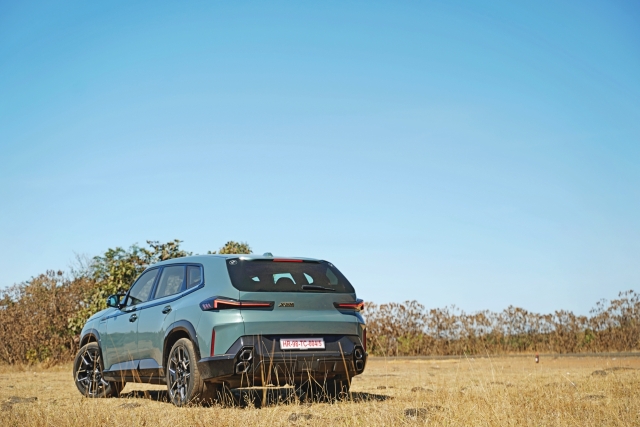That physics-defying M8-like agility of the heavyweight BMW XM stems from multiple factors. Essentially, these are the low centre of gravity from the battery modules mounted low in the floor, together with a tighter set-up for enhanced rigidity, higher tolerance, many details on the limit of the edge of reason, all handled by that taut suspension thanks to BDSM (BMW Dynamic Suspension Management). Wait, it’s called Adaptive M Suspension with M-specific kinematics and elastokinematics. It does a brilliant job of keeping the XM planted on the road with minimal, if not even barely detectable roll. It uses a double wishbone at the front and a five-link rear axle, which, all working together, makes for a thoroughly reassuring feel no matter where you are or how fast you’re going. The steering is power-assisted and rather light-weighted, but offers precise feel and feedback. A 2.8-tonne plug-in hybrid SUV going around a corner at triple-digit speeds or launching from standstill to 100 km/h in just about four seconds should not be possible by what we’ve come to experience ordinarily. That said, this is no ordinary car. It is the next stage of evolution in the performance car order.

To be fair, I didn’t use either of the preset M buttons, “M1” or “M2”, on either side of the wheel, nor the ceremonial launch control. I just stepped on both pedals flat for a second and lifted my left foot off. The surge forward was a silent time-warp for about four-fifths of a second before the twin-twin-scroll-turbo V8 petrol engine kicked in hard, with unrelenting brute force thrusting the XM forward. I felt like I was piloting a ballistic missile with race-car simulator controls. The revs hold. The engine blares, bouncing off the rev-limiter awaiting a yank of the right paddle as it switches a gear and blitzes through the revs yet again, eager for the next shift. But there is no more usable road—usually a limitation for high-performance cars off track. Yes, the BMW XM would be right at home on track. Its handling dynamics beggar belief, the brakes are potent and offer unbelievable stopping power, and it feels unlike anything I have ever driven. Under my breath, I mutter to my colleagues, “Holy sh**! This is the best damn thing I have driven in my entire life.” Punctuated by an exclamatory sigh and release of pent up CO2; probably more than what the car emitted in that initial second when I launched it.

That’s just it. At the end of the day, the BMW XM is a car you can use every day. To take the kids to school. To go to the supermarket. To rush to a business meeting in another city. It has a premium saloon-like 527-litre boot volume, expandable to 1,820 litres, should the need arise, by folding down the rear seats. It has climate control and top-notch safety kit. It has a ground clearance of 220 mm. It has a 450-Nm electric motor and a battery which, when charged to its usable maximum of 25.7 kWh, can travel for around 88 kilometres at three-digit highway speeds with ease, in a calm, quiet manner. The V8 engine can play generator or powerhouse with the flex of the right foot. And there are multiple modes which can alter how it behaves.

On the way back over the 100-odd kilometres, the battery was depleted and a touch of the “M Hybrid” button gives a choice of hybrid, electric or “eControl” modes, the last of which is a battery-save mode focused on recuperation of enough charge to enable more pure-electric drive. The first one, “Hybrid”, makes for maximum range with electric power being used whenever possible for coasting, maintaining speed, and even for not particularly demanding acceleration. Remember the big mild-hybrid V8 performance cars we’ve driven with the indicative torque displays? They showed use of 12 kW (16 hp) and 170 Nm to maintain the highway cruise speed of 120 km/h. The BMW XM’s e-motor makes 197 hp and 280 Nm, with 450 Nm where it matters, at the delivery end. Essentially, this can be used as a range-extended electric car which eliminates the faintest hint of range anxiety anyone may have. There is a 69-litre fuel-tank. With the battery depleted, I was seeing around 11 km/l rather consistently. Had I set off with a charged battery, I believe I would get close to the claimed figure of over 60 km/litre and a total range well over 1,000 km on a tankful. Another throwback, I have already managed 34.5 km/l in the previous-gen BMW 7 Series plug-in hybrid, the 745Le xDrive. It is possible. It just needs to be used right. Else, the engine has to also deal with the dead weight of a high-voltage battery and e-motor, leading to more load. Done right, the effect is spectacular.

Now I have not driven a Pagani Zonda 760RS or even a 911 GT2 RS, nor have I encountered any V8-powered Cayenne Turbo E-Hybrid, but my statement about it being the best car I’ve driven—having experienced a 997 GT3 RS and even an Aventador on India’s own F1 racetrack—seemed to have been an involuntary decision from my heart and nervous system before the brain’s archives could be accessed. Nevertheless, the BMW XM has delivered a punch to the crème of the premium luxury SUV segment with an authority that makes a self-aware enthusiast sit up and take notice. It’s a new-age car for the new-age world. And I would not have it any other way.
Wait. How about the M50d or even the 40d straight-six diesel, instead of the S68 V8 engine? Perhaps, in the near future. However, going by what it is, the S68 should even clear Euro 7 regulations. The BMW XM is a definitive future car available to buy today; for a rather substantial sum of Rs 2.60 crore (base, ex-showroom). A long second sigh, much like the one post-launch, left my own flared nostrils as I typed that line. What an absolutely bonkers automobile!

Need to Know – BMW XM
Price: Rs 2.60 crore (ex-showroom)
Engine: 4,395-cc, twin-turbo, V8, petrol
Power: 489 hp @ 5,400-7,200 rpm
Torque: 650 Nm @ 1,600-5,000 rpm
Battery pack: 29.5-kWh (25.7 kWh net), lithium-ion
Electric motor: 145-kW (197 hp, 280~450 Nm)
Net Peak Output: 653 hp, 800 Nm
Transmission: Eight-speed automatic, all-wheel drive
Suspension: Double wishbone front, multi-link rear, Adaptive M suspension
Weight: 2,710 kg




